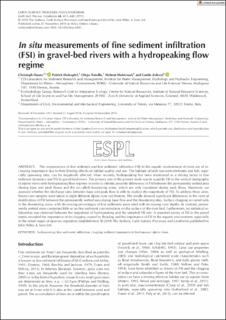Please use this identifier to cite or link to this item:
https://doi.org/10.21256/zhaw-13500Full metadata record
| DC Field | Value | Language |
|---|---|---|
| dc.contributor.author | Hauer, Christoph | - |
| dc.contributor.author | Holzapfel, Patrick | - |
| dc.contributor.author | Tonolla, Diego | - |
| dc.contributor.author | Habersack, Helmut | - |
| dc.contributor.author | Zolezzi, Guido | - |
| dc.date.accessioned | 2018-12-04T14:54:36Z | - |
| dc.date.available | 2018-12-04T14:54:36Z | - |
| dc.date.issued | 2019 | - |
| dc.identifier.issn | 0197-9337 | de_CH |
| dc.identifier.issn | 1096-9837 | de_CH |
| dc.identifier.uri | https://digitalcollection.zhaw.ch/handle/11475/13500 | - |
| dc.description.abstract | The overpresence of fine sediment and fine sediment infiltration (FSI) in the aquatic environment of rivers are of increasing importance due to their limiting effects on habitat quality and use. The habitats of both macroinvertebrates and fish, especially spawning sites, can be negatively affected. More recently, hydropeaking has been mentioned as a driving factor in fine sediment dynamics and FSI in gravel-bed rivers. The primary aim of the present study was to quantify FSI in the vertical stratigraphy of alpine rivers with hydropeaking flow regimes in order to identify possible differences in FSI between the permanently wetted area (during base and peak flows) and the so-called dewatering areas, which are only inundated during peak flows. Moreover, we assessed whether the discharge ratio between base and peak flow is able to explain the magnitude of FSI. To address these aims, freeze-core samples were taken in eight different alpine river catchments. The results showed significant differences in the vertical stratification of FSI between the permanently wetted area during base flow and the dewatering sites. Surface clogging occurred only in the dewatering areas, with decreasing percentages of fine sediments associated with increasing core depths. In contrast, permanently wetted areas contained little or no fine sediment concentrations on the surface of the river bed. Furthermore, no statistical relationship was observed between the magnitude of hydropeaking and the sampled FSI rate. A repeated survey of FSI in the gravel matrix revealed the importance of de-clogging caused by flooding and the importance of FSI in the aquatic environment, especially in the initial stages of riparian vegetation establishment. | de_CH |
| dc.language.iso | en | de_CH |
| dc.publisher | Wiley | de_CH |
| dc.relation.ispartof | Earth Surface Processes and Landforms | de_CH |
| dc.rights | http://creativecommons.org/licenses/by-nc/4.0/ | de_CH |
| dc.subject | Hydropeaking | de_CH |
| dc.subject | Fine sediment | de_CH |
| dc.subject | Clogging | de_CH |
| dc.subject | Sediment management | de_CH |
| dc.subject | Hydropower | de_CH |
| dc.subject | Alpine river | de_CH |
| dc.subject.ddc | 551: Geologie und Hydrologie | de_CH |
| dc.title | In situ measurements of fine sediment infiltration (FSI) in gravel-bed rivers with a hydropeaking flow regime | de_CH |
| dc.type | Beitrag in wissenschaftlicher Zeitschrift | de_CH |
| dcterms.type | Text | de_CH |
| zhaw.departement | Life Sciences und Facility Management | de_CH |
| zhaw.organisationalunit | Institut für Umwelt und Natürliche Ressourcen (IUNR) | de_CH |
| dc.identifier.doi | 10.1002/esp.4505 | de_CH |
| dc.identifier.doi | 10.21256/zhaw-13500 | - |
| zhaw.funding.eu | No | de_CH |
| zhaw.issue | 2 | de_CH |
| zhaw.originated.zhaw | Yes | de_CH |
| zhaw.pages.end | 448 | de_CH |
| zhaw.pages.start | 433 | de_CH |
| zhaw.publication.status | publishedVersion | de_CH |
| zhaw.volume | 44 | de_CH |
| zhaw.publication.review | Peer review (Publikation) | de_CH |
| zhaw.webfeed | Ökohydrologie | de_CH |
| Appears in collections: | Publikationen Life Sciences und Facility Management | |
Files in This Item:
| File | Description | Size | Format | |
|---|---|---|---|---|
| 2019_Hauer-etal_In-situ-FSI-measurements.pdf | 1.66 MB | Adobe PDF |  View/Open |
Show simple item record
Hauer, C., Holzapfel, P., Tonolla, D., Habersack, H., & Zolezzi, G. (2019). In situ measurements of fine sediment infiltration (FSI) in gravel-bed rivers with a hydropeaking flow regime. Earth Surface Processes and Landforms, 44(2), 433–448. https://doi.org/10.1002/esp.4505
Hauer, C. et al. (2019) ‘In situ measurements of fine sediment infiltration (FSI) in gravel-bed rivers with a hydropeaking flow regime’, Earth Surface Processes and Landforms, 44(2), pp. 433–448. Available at: https://doi.org/10.1002/esp.4505.
C. Hauer, P. Holzapfel, D. Tonolla, H. Habersack, and G. Zolezzi, “In situ measurements of fine sediment infiltration (FSI) in gravel-bed rivers with a hydropeaking flow regime,” Earth Surface Processes and Landforms, vol. 44, no. 2, pp. 433–448, 2019, doi: 10.1002/esp.4505.
HAUER, Christoph, Patrick HOLZAPFEL, Diego TONOLLA, Helmut HABERSACK und Guido ZOLEZZI, 2019. In situ measurements of fine sediment infiltration (FSI) in gravel-bed rivers with a hydropeaking flow regime. Earth Surface Processes and Landforms. 2019. Bd. 44, Nr. 2, S. 433–448. DOI 10.1002/esp.4505
Hauer, Christoph, Patrick Holzapfel, Diego Tonolla, Helmut Habersack, and Guido Zolezzi. 2019. “In Situ Measurements of Fine Sediment Infiltration (FSI) in Gravel-Bed Rivers with a Hydropeaking Flow Regime.” Earth Surface Processes and Landforms 44 (2): 433–48. https://doi.org/10.1002/esp.4505.
Hauer, Christoph, et al. “In Situ Measurements of Fine Sediment Infiltration (FSI) in Gravel-Bed Rivers with a Hydropeaking Flow Regime.” Earth Surface Processes and Landforms, vol. 44, no. 2, 2019, pp. 433–48, https://doi.org/10.1002/esp.4505.
Items in DSpace are protected by copyright, with all rights reserved, unless otherwise indicated.